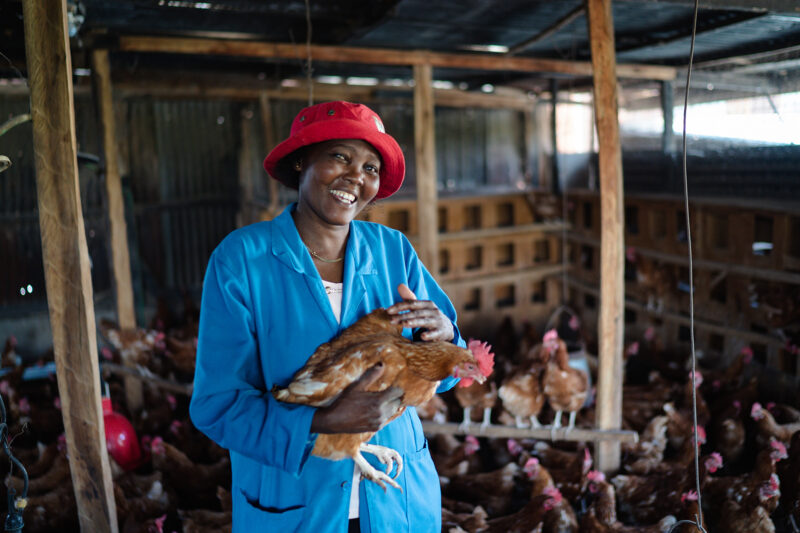
Small-scale poultry farming is a major source of income for many rural households in Kenya and contributes to household food security and nutrition. However, preventing transmission of foodborne pathogens such as Salmonella and Campylobacter is a persistent challenge in poultry production systems around the world. Strengthening food safety requires not only the adoption of safer handling practices but also aligning those interventions with gender roles, responsibilities, and risks. A new study highlights the significant role played by women and youth in small-scale poultry production in Kenya and identifies key activities to increase their success in reducing foodborne illness.
The team, led by Barbara Kowalcyk, associate professor in the Department of Food Science and Technology at The Ohio State University (OSU), analyzed findings on gender roles and youth participation in Kenyan poultry production. The trends in gender roles and youth participation will be used to develop culture- and gender-specific food safety practices to reduce foodborne disease risks as part of the Chakula Salama project funded by USAID’s Feed the Future Innovation Lab for Food Safety.
“This review provides a unique perspective on how women, youth, and men can have differing levels of exposure to food safety concerns on smallholder farms in Kenya due to the specific tasks that they conduct in the poultry value chain,” said lead author Ariel Garsow, an alumna of the Kowalcyk Lab at OSU now serving as a technical specialist in food safety with the Global Alliance for Improved Nutrition’s USAID-funded EatSafe program. “Other articles or reports mainly cover exposure risks or roles in the value chain, but this review provides a synthesis of how these topics overlap.”
Transmission of foodborne disease can occur at many points in the poultry value chain, from the risk of contact with foodborne pathogens from water, poultry feed, or chickens during production to the consumption of contaminated poultry products at meals. Key findings of the review include:
- Women and youth play central roles in smallholder poultry production
- Women are primarily responsible for the care and keeping of chickens, including the cleaning of poultry houses, feeding, and treating illnesses
- Women spend more time engaged in daily activities around poultry production than men, especially when flocks are smaller than 500 chickens
- Men, women, and youth are all involved in poultry processing, transportation, and consumption
Gender and youth roles in poultry farming impact public health in two ways. A poultry farmer’s personal risk of foodborne illness is directly affected by the specific role they play in production, with women and youth facing a higher risk from daily involvement with animal husbandry including exposure to manure when cleaning pens. In addition, the greater participation of women and youth within poultry production provides vital opportunities for them to prevent foodborne pathogens from reaching consumers.
The review also examined who controls the income generated by smallholder poultry farming. Typically, women own chickens when flocks are small. However, when flock sizes on smallholder farms increase to the point where they have the potential for commercial viability, men usually take over and control the income.
“There’s data to indicate that if the woman is much more involved in either decision-making or the control of the income, it benefits the family a lot more,” said Kathleen Colverson,
associate research scientist at the University of Florida and gender lead for the project. “So, what we’re also concerned about is how can we not only reduce pathogen load but find potential mechanisms for helping the women to control more of the income that’s generated.”
Because of the central roles played by women and youth in poultry production, the authors recommend key activities to bolster their success in safer poultry production, including trainings on hygienic practices that target women and youth—but are sensitive to their available time and locations, providing financial support to women and youth, empowering women’s decision making in poultry sales, and addressing within-household inequities in chicken and egg consumption. In addition, they cite the need for policies to support gender and youth empowerment and greater inclusion of the perspectives of women and youth in the development of food safety priorities and approaches.
Garsow says findings from the review are being used to help design culturally-appropriate, gender-specific interventions to mitigate risks of Salmonella enterica and Campylobacter spp. for Kenyan consumers through the Chakula Salama project.
“More research is needed to determine connections between foodborne disease and who conducts the particular activity in the poultry value chain,” said Garsow. “Overlaying information on how women, men, and youth are involved in the poultry value chain in Kenya with food safety risks provides evidence of where and to whom interventions should be focused.”
In addition to Garsow, Colverson, and Kowalcyk, co-authors include Erika G. Kim (OSU); Sanja Illic (OSU); Catherine Kunyanga (University of Nairobi); and Abdiaziz Bainah (University of Nairobi). The review was published in the December 2, 2022, issue of Frontiers in Sustainable Food Systems.
Christina Frank is a freelance writer with the Feed the Future Innovation Lab for Food Safety.

